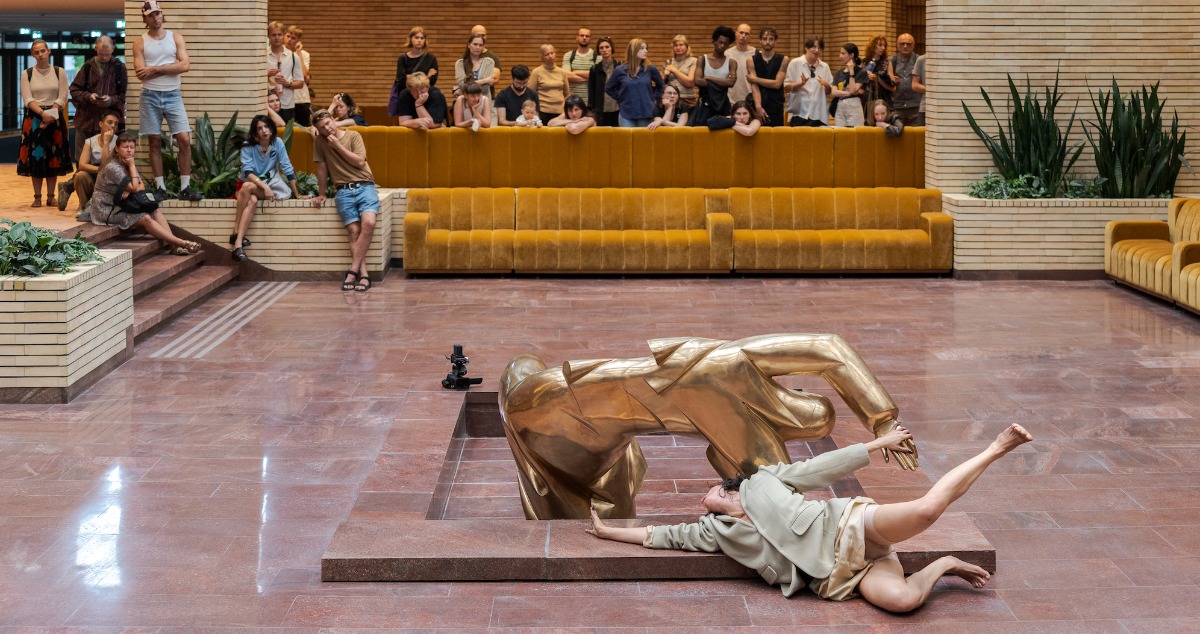
Vilnius. Its Poker and Its Biennale
Two large art events are taking place in Vilnius in honour of the city’s 700th anniversary
Vilnius is a city of many historical strata, a palimpsest-city, a myth-city, a text-city. A city of drama, love and ambition. 2023 marks its 700th anniversary and this year’s celebrations are on a grand scale. Two art events should be highlighted in particular, both of which play on Vilnius’ history, atmosphere and topography in different ways.
First, the Mo Museum, located in the city’s centre, has played a winning hand, by hosting a gripping, breath-holding game of Vilnius poker. That is the name of the exhibit, staged by Europe-wide renowned director Oskaras Koršunovas.
The exposition is very fresh and unusual in its approach to viewer experience – especially considering that much of it is not visual. Sound plays a huge part here, at times conflicting, clashing and almost hysteric, at other times – meditative and enchanting. It’s no wonder the exhibition has its own composer, Antanas Jasenka. This whole project is also built around a text and the quotes, strikingly plastered across the walls, are yet another important part of the exposition, contributing to the overall dramatic polyphony of the event. The quotes come from Ričardas Gavelis’ novel Vilnius poker; not only does the exhibition borrow the book’s name, it also references its structure. Published in 1989 the novel became a true manifesto of Lithuanian post-modernism, of inner and literary freedom. Moreover, it’s a book where Vilnius itself becomes an important character. “Anything is possible in Vilnius”, – writes Gavelis. For him, however, Vilnius becomes an almost universal model of a city: “Vilnius is everywhere. In every real city you can find houses, streets and people of Vilnius”.
Visitor at the work of Žigimantas Augustinas (1973) «Phantom of a hybrid of Queen Bona Sforza d'Aragona and current president of Lithuania Dalia Grybauskaitė». Photo: MO Museum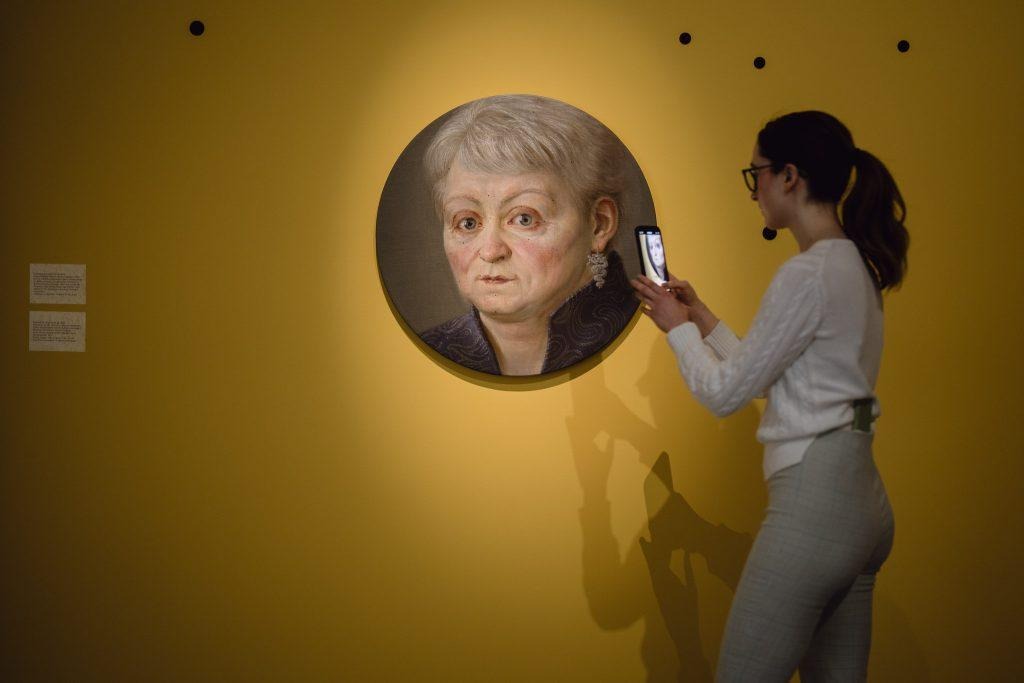
The exhibition includes around 150 works from 50 Lithuanian artists, which freely interpret the themes relevant to Gavelis’s writing: memory, identity, freedom and enslavement. The exposition’s structure is akin to a labyrinth, with its own pockets and audiovisual “outpourings”. The heart of the exhibit is a dark, curving corridor, briefly illuminated by flashes of light. Passing along its curved glass wall visitors can observe a hall they’ve just been to, and where the now transparent wall looked as an impenetrable reflective surface. In essence it’s something of an ability to look into the recent past, into an event that you have only just left. On display here is the masterful work of yet another of the exposition’s co-creators, its architect Gintaras Makarevičius, an artist and stage designer renowned in Lithuania.
Photo: MO Museum
Photo: Sergej Timofejev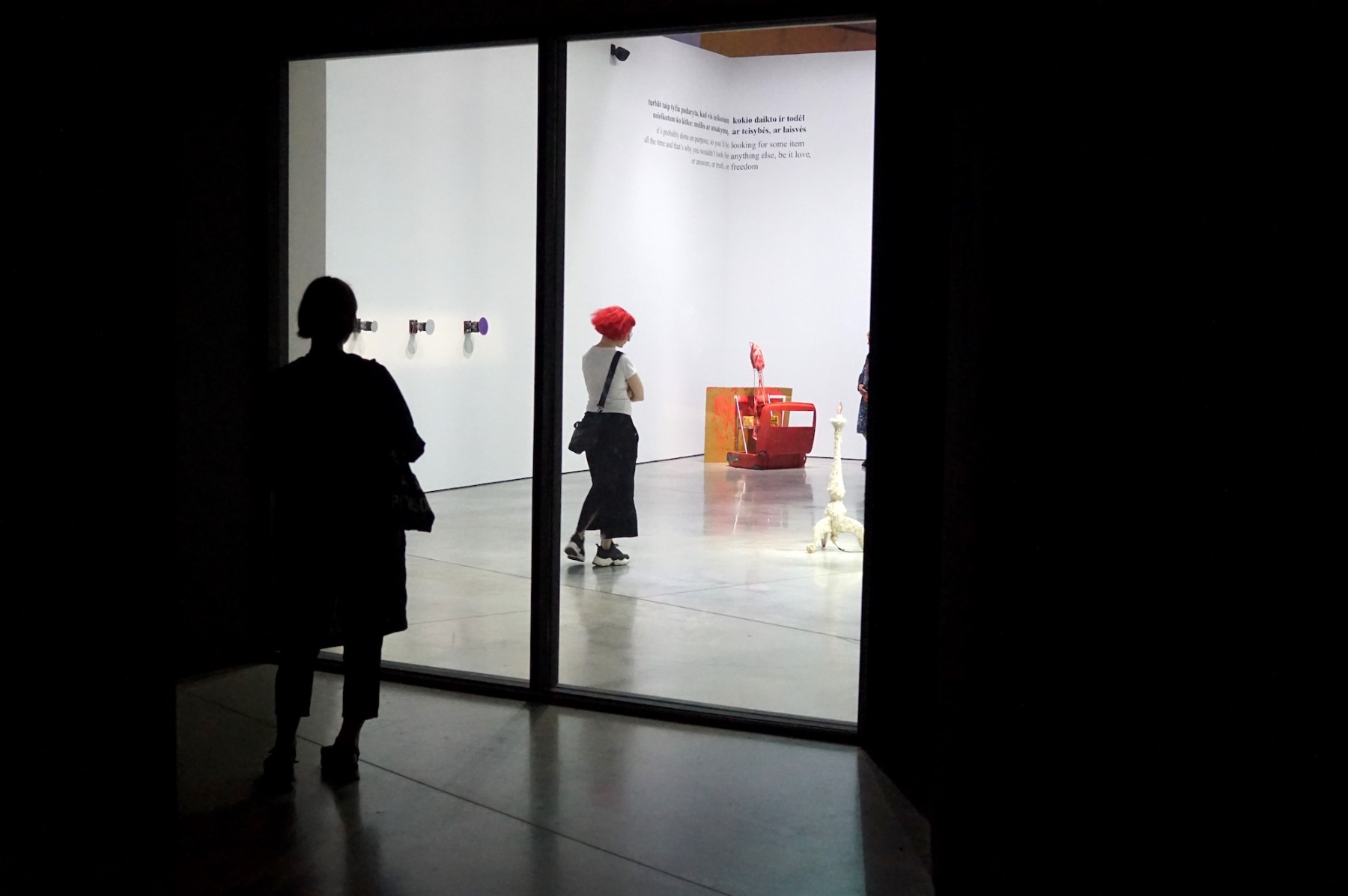
One of his works is part of the exhibit proper. In general, there is a wide range of generations on display – from the contemporaries of Vilnius poker’s author, to the artists of the 00’s, to the youngest faces on the scene. The range of media is also extremely polyphonic – painting, objet d’art, music video and installation. The exhibition opens with a hall dedicated to paintings of the 1970-1980s, in which a collection of works of Kostas Dereškevičius, who was born in 1937 and died in January this year, is especially striking. Dark tones, with sudden splashes of bright, vibrant colour wandering over them; women seen through the windows of trolleys and buses; rows of post boxes in entrance ways; a city view through the slight peak in a jeans zipper; authentic cheese and cabernet labels adorning a typical couple portrait, as they hold a bouquet of roses that looks like it came from a bridal shop. The whole of reality that kept on swelling, until 1989, the year Gavelis wrote his novel, when it burst into atoms, which would later chaotically gather into the post-soviet world.
Kostas Dereškevičius. Without a title. 1974. MO Museum collection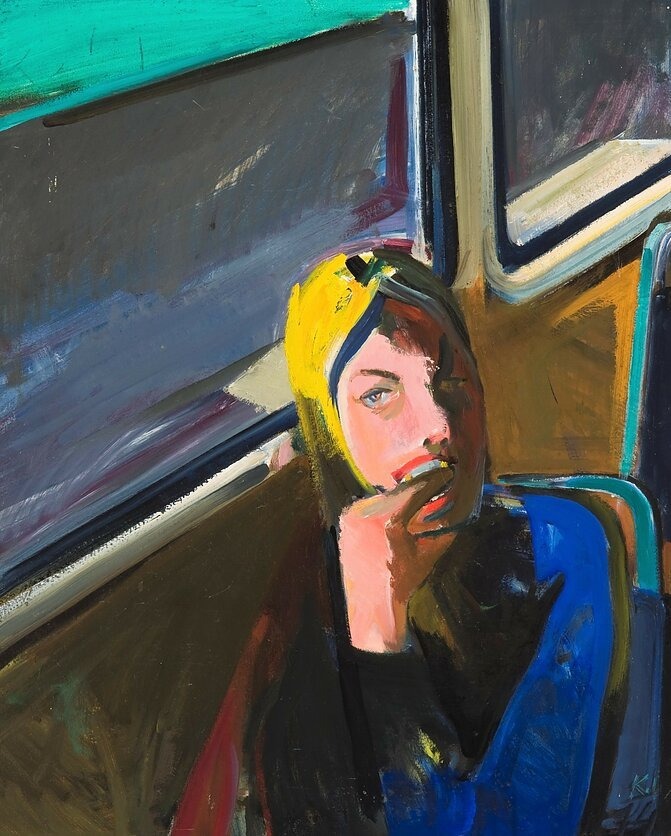
Vilnius poker exhibition rattles and rumbles, dragging you in like a boa constrictor, as you traverse its space/body, until you complete a loop and end up back at the hall of paintings from ”late sovok”. It seems that everything here is in a bind calculated, logically, emotionally and psychologically. The exposition is open at Mo Museum through the whole year of 2023. It can be of interest to curators and other related professionals from the Baltic to take a look at a different way of organising exhibitions, that’s more rooted in theatre. A Lithuanian curator told me that the project was, of course, a success, but she was still bothered that some boundaries were crossed: "Us, we don’t go to theatres and to stage plays there".
In a sense, an opportunity for curators to stage a kind of play, to involve actors in something that comes together as a cohesive art piece has unveiled itself on July 23rd at VB23, the Vilnius Biennale of Performance Art. It was preceded by a strong preamble this January in the multi-staged performance Aphotia by Lithuanian artist Emilija Škarnulytė, inspired by the very architecture of the National Theater of Opera and Ballet, where the performance took place. Aphotia plays out as if Škarnulytė flipped the building upside down and projected it onto the ocean floor. “In Aphotia, I look into the layers of the ocean – its surface and what lies beneath it. This translates into the structure of the work, which becomes a three-part journey into the depths of the oceans, with differences in temperature, oxygen content, forms of life, etc.”, – was one of the artist’s original comments.
Hiatus that followed after the introduction in January was disrupted by the main program starting in the middle of summer. From July 23rd to August 6th the biennale’s events are going to take place in various, often surprising spaces, and some of them wouldn’t be familiar even to Vilnius residents – for example, the repair depot of the Lithuanian railway, or the Liepkalnis water basin. For the main theme of the first biennale is ultimately Vilnius, “the city itself – a human-made and human-operated environment that we share with other life forms, and where different histories, myths, activities, interests, desires and visions clash, coexist and intersect”. During the two-week program 38 artists participate in VB23, holding a total of 31 performances across 17 different places in Vilnius. Almost all events of the biennale are free and open to everyone.
Performance «Gimbutas Street Band» by poet and art historian Laima Kreivytė, US poet and writer Eileen Myles, and curator Justė Kostikovaitė. Photo: Andrej Vasilenkо, VB23


In the street near Pamėnkalnio gallery took place the first series of performances by poet and art historian Laima Kreivytė, US poet and writer Eileen Myles, and curator Justė Kostikovaitė. Along with two of their Lithuanian colleagues these three women held something of a feminist rally, both in Lithuanian and English, in tribute of Maria Gimbutas, an archaeologist and anthropologist, known for her theory of the Neolithic European matriarchy, a pacifist, egalitarian and nature-respecting society, which preceded the Indo-European warrior patriarchies. Gimbutas Street Band performance called for at least a temporary name change of the nearby Jogailos street (named after the Grand Duke Jogaila, who converted Lithuania from paganism to Christianity in 1387) into Gimbutas street, to honour feminist and scientist, who spent her childhood years in a house on that street. The performance-rally was energetic and spirited. The audience met it with applause, supportive of the idea that street names in Vilnius should become less patriarchal in general (currently 90% of streets named after people reference male historical figures).
Performance «Song Sing Soil» by Eglė Budvytytė and Marija Olšauskaitė. Photo: Andrej Vasilenkо, VB23
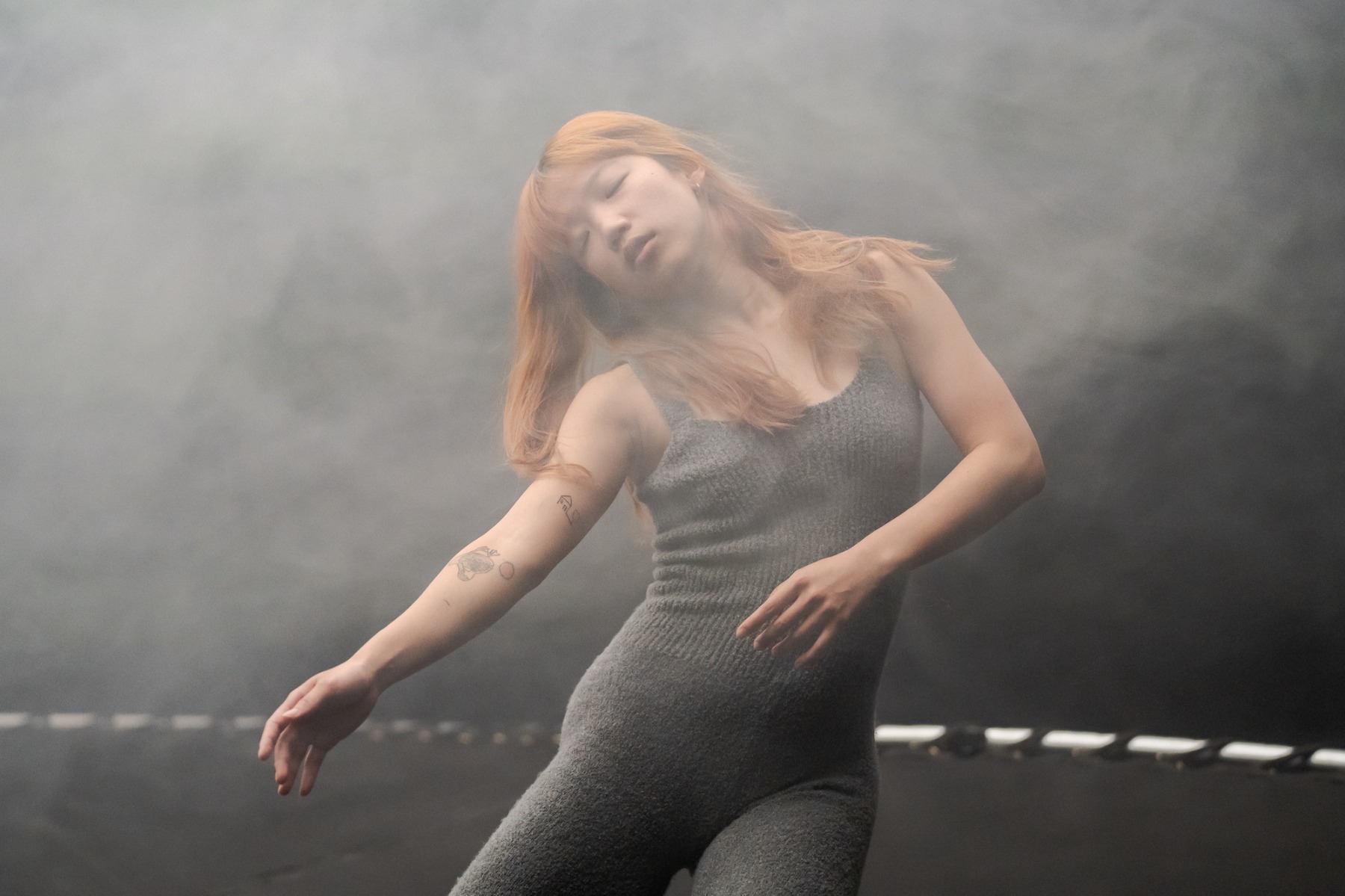
On the same day the first show of Song Sing Soil performance was held by Eglė Budvytytė and Marija Olšauskaitė, both of whom had taken part in last year’s Venice Biennale main exhibit. Held at the Art-typography building, the performance takes place in a dark room with a giant trampoline at the centre. Three performer-dancers lie on its surface far away from each other. Even when the music, a meditative electronic piece with lyrics in English, starts, the dancers don’t move, but eventually the eye begins to notice amplitudes of subtle, minute motions. As they become more apparent, they transition into a dance, until at some point halting again, as time slows down and the motions are imbued with a double meaning. The music ends, and the three dancers abstain from making their last steps on the creaky floor to freeze once more – this time with their backs to the walls, behind the rows of viewers. “Song Sing Soil urges us to slow down, try to become accustomed to the state of transience, and expand our abilities to listen and feel into things", – says the biennale’s website.
Venue of the performance «A Guiding Light» by world renown artists Liam Gillick and Anton Vidokle. Photo: Andrej Vasilenkо, VB23

This abruptness of action is developed to its furthest extent by another VB23 performance – A Guiding Light by world-renown artists Liam Gillick and Anton Vidokle. On the night of July 24th the audience gathered at a railroad depot, where a two-hour spectacle unfolded and was filmed for further use as a video piece. Surrounded by railways, motionless train cars and various railroad machinery, musicians would climb onto the turntable platform, and unitedly launch into playing energetic, rousing melodies, abruptly stopping, as the music would dissolve, ending with a single flute note or a spread of percussion. This would repeat again and again.

Liam Gillik and participants of the performance. Photo: Andrej Vasilenkо, VB23
Next day my question was: “Is failure, not coming together the main emerging theme here?” Anton Vidokle answer was: “Yes, the not coming together of… radical politics. All of these songs are from recent revolutions, from the so-called colour revolutions and the Arab spring. The musicians are trying to remember them. But we always interrupt them. They can never play the whole piece… It’s a statement on the difficulty of revolutions and political movements. In most cases they can’t actually change anything. Because the very idea of revolution revolves around a turn, and turning eventually makes a circle. We return to the same place we’ve started from. That’s why we use a train turntable as our location. These songs aren’t just any songs, since music in revolutions is also used as an organisational tool, it’s not mere aesthetics, it’s not made for pleasure. Organising this was very tough, but we got lucky with the weather, so we were able to shoot some very beautiful material, and we’ll have some kind of video in a year’s time”. This video will continue A Guiding Light – a 2010 piece shot by Anton Vidokle and Liam Gillick as a discussion on the place and role of the artist in today’s society.
This isn’t the only open-air spectacle taking place in Vilnius. On july 28th, near the fountain of the Lithuanian National Theater of Opera and Ballet a performance called Cat Practice by Swedish artist and choreographer Pontus Pettersson was held, while Adam Christensen, a British interdisciplinary artist, showcased his latest work Damascus, Copenhagen, Fetish Shop at the new Vilnius sightseeing spot, the Vingriu Spring Gardens. The biennale programme has many more events held in many different spots of the city – from the National Art Gallery and the Kalvarijos Market, to the tech campus of Tech Zity Vilnius and the old Jewish Piromontas cemetery.
What Are the Dreams of Concrete? performance from the Eye Gymnastics duo (Viktorija Damerell, Gailė Griciūtė) of experimental music and performance is shaping up to be very interesting, taking place on the 2nd and 3rd of August in one of Vilnius’ most spectacular underground structures – the Liepkalnis Water Basin. More than a century old and located under one of the hills Vilnius was built on, the basin possesses incredible acoustic properties. Another biennale artist, Kris Lemsalu, who represented Estonia at the 2019 Venice Biennale, also turned toward water infrastructure – she will present her Lust Fest performance on August 5th at the Lazdynai swimming pool. "Rowing and singing amidst the pink and blue ripples of chlorinated water and surrounded by synchronised swimmers, the artist explores our deep undercurrents of passion, love and consolation".
VB23’s eventful program will conclude on August 6th with Throwing Balls At Night performance by Italian artist Jacopo Miliani held on the tennis court of the Vilnius Bernardine Garden. Inspired by Claude Debussy’s 1913 ballet Jeux (Games), conceived as the first homosexual male ballet, the dancers of this new rendition will reinterpret the ballet’s story.
Overall, even judging by the first performances this biennale can be said to be an excellent chance to rethink the way urban spaces can be utilised. Vilnius is a diverse city, and the biennale’s program includes performances that are accordingly diverse in style and structure. The full picture will reveal itself only after the biennale concludes. However, we hope it becomes a tradition, and the biennial will be back in two years’ time, when the anniversary passes, but the interest in Vilnius will remain both with its locals and visitors. We’re happy to play Vilnius poker again and again, with cards constantly shuffled by history, politics, peculiar Vilnius’ metaphysics and desire for freedom.
Title image: Performance «lalia» by Basel-based artists Dorota Gawêda and Eglė Kulbokaitėокайте. Photo: Andrej Vasilenkо, VB23